2 成都信息工程大学大气科学学院, 四川 成都 610225)
在夏季,北半球对流层上层、平流层低层存在着一个强大且稳定的半永久性高压系统,它西起非洲西海岸,东至西太平洋,东西方向横跨约半个地球,是北半球夏季高层除极涡外最大最稳定的环流系统,这一高压系统中心位于南亚大陆,主要位于青藏高原和伊朗高原之上,所以被称之为南亚高压。南亚高压的形成与维持,往往被认为是青藏高原热力作用的结果[1~3]。吴国雄等[4]提出“感热气泵”的概念,认为春夏季高原表面感热输送造成了低层气流向高原地区辐合,形成了夏季高原上空强烈的上升运动与降水,降水过程释放了大量的凝结潜热,进一步增强了上升运动,加剧了高空辐散,从而维持着高原上空的高压;吴国雄和刘屹岷[5]进一步提出“热力适应”理论,认为高原上非绝热加热在垂直方向上的非均匀分布形成和维持了高原上空的南亚高压。
南亚高压的位置存在明显的季节变化,在东西方向上它的活动可以分为东部型、西部型和带状型[6],并且与西太副高存在着“相向而行,相背而去”的变化规律[7]。南亚高压的东西振荡主要与长波系统的调整有关,受南亚高压南北侧或者东西侧的大气环流影响,同时还受青藏高原的感热和我国东部平原的潜热作用影响[8];此外,南亚高压的东西振荡还与极涡活动有关,当极涡面积扩张时,南亚高压偏西,反之则偏东[9]。南亚高压的东西振荡与亚洲季风区的降水有非常显著的关系,当南亚高压偏东时,孟加拉湾地区、青藏高原南部、中国南海地区、长江流域至日本南部地区降水偏多,印度和朝鲜半岛地区降水偏少;当南亚高压偏西时,降水异常分布刚好相反[10~12]。
除东西振荡外,南亚高压还存在着南北移动。在冬季,南亚高压位于热带太平洋上空,到了春末,高压中心向西北移动到中南半岛,到夏初进一步移动到印度半岛;6月到7月,南亚高压逐步增强并北移,并在7月、8月稳定在青藏-伊朗高原上空[13~15]。南亚高压的北移过程与我国东部夏季雨带的推进有很好的对应关系[12, 15~16],当高压脊线跳到25°N,长江流域进入梅雨期,当高压脊线跳到33°N以北,长江流域梅雨期结束,华北进入雨季[15]。在年际和年代际尺度,印度洋海温异常被认为是影响南亚高压南北位置的主要因素,热带印度洋增暖可以激发Matsuno-Gill型大气响应,在对流层上层激发出异常反气旋,导致南亚高压偏南[13]。
目前对南亚高压的研究主要是探讨其季节到年代际尺度的变化[12~13, 17]。关于其更长时间尺度的变化特征,王宁等[18]利用气候模式在轨道参数强迫下,研究了全新世南亚高压在千年时间尺度上的东西振荡特征,发现南亚高压东脊点自早全新世逐渐向西移动,到中全新世后又逐渐向东移动,主要受春季太阳辐射的影响。南亚高压的东西振荡与东亚夏季风存在不稳定的关系,在早、中全新世,它们之间存在正相关关系,而到中、晚全新世则变为反相关关系。因此,南亚高压的东西振荡与全新世东亚夏季风演化的联系相对较弱。
全新世以来,随着夏季太阳辐射的持续减少,亚洲夏季风强度持续减弱[19~21],然而众多代用记录重建结果以及一些模拟结果却显示降水变化存在显著的区域差异,不同区域全新世最适宜期(最大降水)存在显著差异[22~27],反映了气候系统内部反馈机制对亚洲夏季风降水有显著的调节作用[28~30],然而目前对其中的一些物理机制还缺乏理解,特别是对全新世南亚高压的南北移动特征还没有深入研究,它与亚洲夏季风是否存在稳定的关系也不清楚。因此,本文利用一个全球海-气耦合模式在轨道强迫下的数值模拟试验数据,研究南亚高压的南北振荡对太阳辐射的响应特征,并进一步探讨其与亚洲夏季风降水的关系,以期加深理解全新世亚洲夏季风演化机制。
1 资料与方法为研究全新世南亚高压的南北移动特征,及其与亚洲夏季风降水的关系,本文利用我们已有的一个全新世整个时段(9.5~0 ka B.P.)的数值模拟结果[18]进行分析。该模拟所用的气候模式为基尔气候模式(Kiel Climate Model,简称KCM)[31]。KCM是一个完全耦合大气和海洋-海冰过程的全球气候模式,它的大气模块为ECHAM5[32],海洋模块为NEMO,包括OPA9海洋环流模式和LIM2海冰模式,大气模式和海洋模式通过OASIS3耦合器完全耦合。KCM模式没有进行距平修正和任何形式的通量校正,包括淡水通量、热通量和风压。ECHAM5的水平分辨率为T31(3.75°×3.75°),垂直方向上共19层,最高达10 hPa。NEMO的水平分辨率为2°的墨卡托网格,并在赤道地区进行加密,经向分辨率达到0.5°(ORCA2网格),垂直方向上共31层。KCM模式已被用来研究气候系统内部变率[33~34]和外强迫气候变率[35~36]。
本文包含3个模拟试验,包括两个平衡态试验(简称H9K和H0K试验)和一个瞬变试验(简称HT试验)。首先,利用KCM模式分别对工业革命前(0 ka B.P.,H0K)和早全新世(9.5 ka B.P.,H9K)这两个时间片段在轨道参数(偏心率、黄赤交角和岁差)[37]的强迫下积分1000年。H0K和H9K试验的初始场均采用莱维图斯气候数据。除轨道参数外,包括温室气体(CO2、CH4和N2O)浓度和大陆冰盖在内的其余强迫因子均设为工业革命前的数值。
当H9K试验积分1000年后达到平衡状态,然后从H9K试验的最后一年开始对全新世以来(9.5~0 ka B.P.)的气候在地球轨道参数[37]的强迫下进行瞬变模拟[38]。为了节省积分时间,全新世整个时段瞬变模拟试验方案采用轨道参数变化的10倍加速技术[39]。地球轨道参数变化引起的太阳辐射变化是全新世气候变化的主要驱动因子,而其他因子如温室气体浓度和大陆冰盖变化基本不大,并且它们的强迫作用相对轨道强迫而言作用较小[40]。因此,本文的数值模拟试验只考虑轨道参数改变引起的太阳辐射变化的影响。轨道参数数据来源于ftp//ftp.ncdc.noaa.gov/pub/data/paleo/insolation/orbit91,由于目前轨道参数数据为每隔千年一个数值,因此需要将轨道参数数据均匀地插值到模拟的各个时间点上。
2 结果 2.1 全新世南亚高压南北移动特征在现代,夏季(6~8月)南亚高压在亚洲南部上空呈东西向的长椭圆状(图 1a),以200 hPa高度上12500 gpm为特征线,南亚高压的核心区域覆盖了印度季风区和东亚季风区部分地区,包括阿拉伯半岛、伊朗高原、印度半岛北部、青藏高原、中南半岛北部以及我国长江以南地区。南亚高压平均脊线位置在27.5°N附近,在脊线位置上纬向风风速为零,脊线以北为西风,位于里海和南疆上空的西风急流中心刚好处在南亚高压核心区域的正北方向,脊线以南为东风(图 1a),因此,南亚高压中心的南北振荡也反映了高空西风环流的扩张与退缩[16]。KCM模拟的工业革命前的南亚高压与现代观测结果存在一定的差异(图 1b)。首先,南亚高压的强度要显著弱于现代观测结果,南亚高压核心区域的特征线强度大致为12390 gpm;其次,南亚高压东侧为西北-东南走向,与观测结果的东西向不一致。模拟的南亚高压核心区范围与现代基本一致,而模拟的西风急流强度要较现代强,并且位置偏北。由于南亚高压东侧呈现西北-东南走向,高空东风环流范围要较现代小。因此,KCM对南亚高压的模拟存在一定偏差,这个偏差使得模拟的整个全新世的南亚高压强度偏低(图 1c),但KCM模拟的工业革命前南亚高压脊线的南北位置与现代观测结果基本一致。
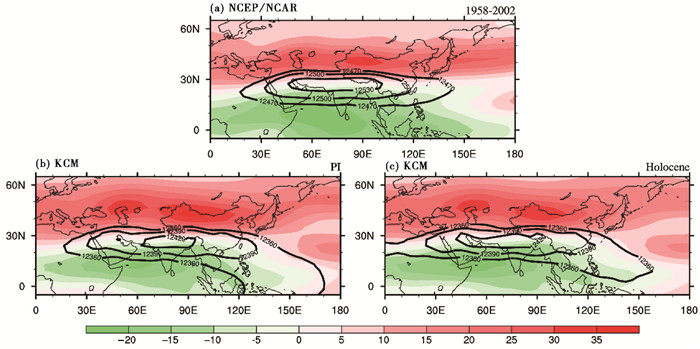
|
图 1 夏季200 hPa位势高度(单位:gpm;等值线)和纬向风(单位:m/s;色度) (a)1958~2002年NCEP/NCAR再分析资料,(b)KCM工业革命前(PI)模拟(H0K),(c)KCM全新世模拟(HT) Fig. 1 Climatological summer geopotential height(units: gpm; contours)and zonal winds(units: m/s; shading)at 200 hPa during 1958~2002 based on NCEP/NCAR reanalysis data (a), during the pre-industrial(PI)period(H0K) (b) and during the Holocene(HT) (c) from the KCM simulations |
为了分析全新世以来南亚高压的时空演化特征,我们对全新世3个典型时期(早全新世9.5 ka B.P.、中全新世6 ka B.P.和晚全新世PI)[41]进行分析,同时,为了排除气候系统内部变率引起的波动,我们选择3个千年时段(9.5~8.5 ka B.P.、6.5~5.5 ka B.P.和1~0 ka B.P.)的平均分析这3个典型时期的南亚高压特征。早全新世以来,12400 gpm特征线覆盖的范围先减小后增大,反映了南亚高压强度先减弱后增强,而南亚高压东脊点的位置先向西移动后又向东移动[18](图 2)。除东西振荡外,南亚高压中心在南北方向也出现位置变化,南亚高压的南北振荡可以反映在200 hPa高度上纬向风0线(纬向风分量为0)的南北位置变化上。由图 2a可以看到早全新世纬向风0线在红海和波斯湾的最北端,此后开始逐渐向南移动(图 2b和2c)。因此,全新世以来南亚高压中心呈现逐渐向南的运动趋势。为进一步量化全新世南亚高压中心的南北移动特征,我们采用魏维等[13]的方法定义了南亚高压的南北指数(INS),INS=Z200(27.5°~32.5°N,50°~100°E)-Z200(22.5°~27.5°N,50°~100°E),其中Z200为夏季200 hPa高度上的位势高度。从图 1c可以看出南亚高压的脊线在27.5°N附近,而脊线为同一经度上位势高度最大值处,当脊线向北移动时,27.5°N以北的位势高度增加,27.5°N以南则减小,INS偏正,脊线向南移动时则刚好相反。因此,这个INS指数可以很好地指示南亚高压中心的南北移动。模拟的INS逐渐由正偏负(图 3),反映了全新世以来南亚高压中心逐渐向南移动的趋势,也反映了高空西风环流逐渐向南扩张的趋势。
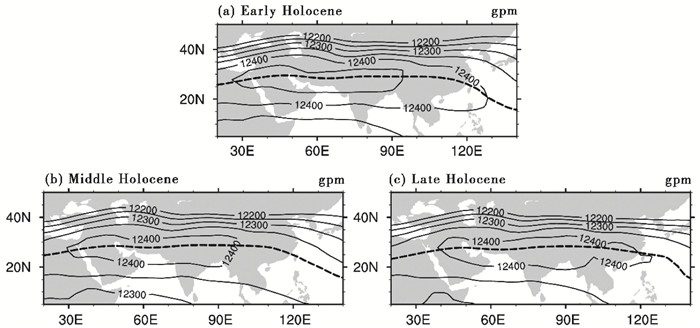
|
图 2 KCM模拟的200 hPa位势高度(单位:gpm;实线),虚线表示南亚高压的脊线(纬向风为0) (a)早全新世(9.5~8.5 ka B.P.);(b)中全新世(6.5~5.5 ka B.P.);(c)晚全新世(1~0 ka B.P.) Fig. 2 Simulated summer mean geopotential height(units: gpm; solid lines)at 200 hPa during the Early Holocene (9.5~8.5 ka B.P.) (a), the Middle Holocene(6.5~5.5 ka B.P.) (b), and the Late Holocene(1~0 ka B.P.) (c). Dashed lines indicate the ridge line of the South Asia High where the zonal wind equals zero |
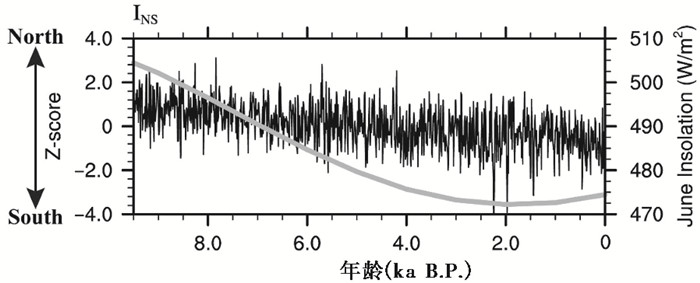
|
图 3 KCM模拟的南亚高压南北偏向指数(INS),灰线为6月30°N太阳辐射 Fig. 3 Simulated time series of the index INS. Gray line indicates June insolation at 30°N |
全新世期间,夏季太阳辐射的变化(图 3)使得亚洲夏季风降水出现显著的变化(图 4),在印度季风区的阿拉伯半岛、伊朗高原、印度半岛北部和最南端、青藏高原西部,以及东亚季风区的中国北部和蒙古大部分地区,早全新世降水相对于晚全新世增加了80 %以上,中国东部地区增加了不到20 %,相反,中国中部、朝鲜半岛、日本和印度半岛东部、中南半岛南部,降水减少了0~40 %。KCM模拟的全新世亚洲夏季风降水变化趋势与代用记录重建结果基本一致[42~44](图 5b~5d),但变化幅度可能存在一定的偏差。在季风区外的中国新疆和中亚东部,降水减少了20 %以上,这在许多代用记录里也有所反应[45~46],特别是新疆的黄土记录[45]也显示这一区域全新世以来持续变湿(图 5a)。因此,亚洲地区的夏季降水对同一强迫(轨道强迫)产生了不同的响应,反映了气候系统内反馈机制对这一区域的降水有显著的影响。南亚高压作为亚洲夏季风系统的重要组成部分,它能否影响亚洲夏季风降水?
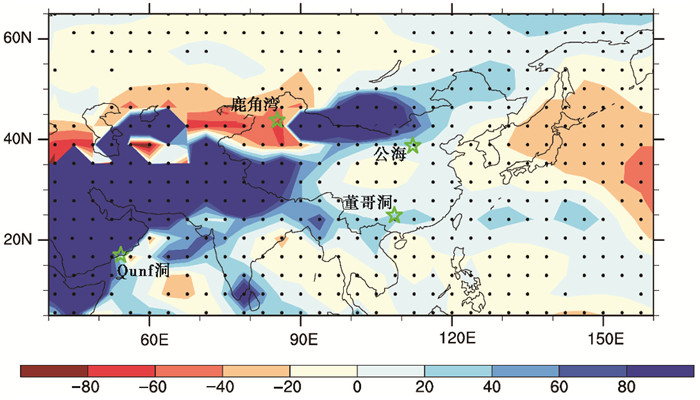
|
图 4 早全新世(9.5~8.5 ka B.P.)夏季降水相对于晚全新世(1~0 ka B.P.)的变化百分率(单位:%) 黑点区域表示降水变化通过0.01显著性检验;绿色星号表示鹿角湾、公海、董哥洞和Qunf洞位置 Fig. 4 Percentage changes in summer precipitation(units: %)during the Early Holocene(9.5~8.5 ka B.P.)relative to the Late Holocene(1~0 ka B.P.). The stippled areas indicate changes that are significant at the 0.01 confidence level. The green stars indicate the locations of Lujiaowan, Gonghai Lake, Dongge cave and Qunf cave |
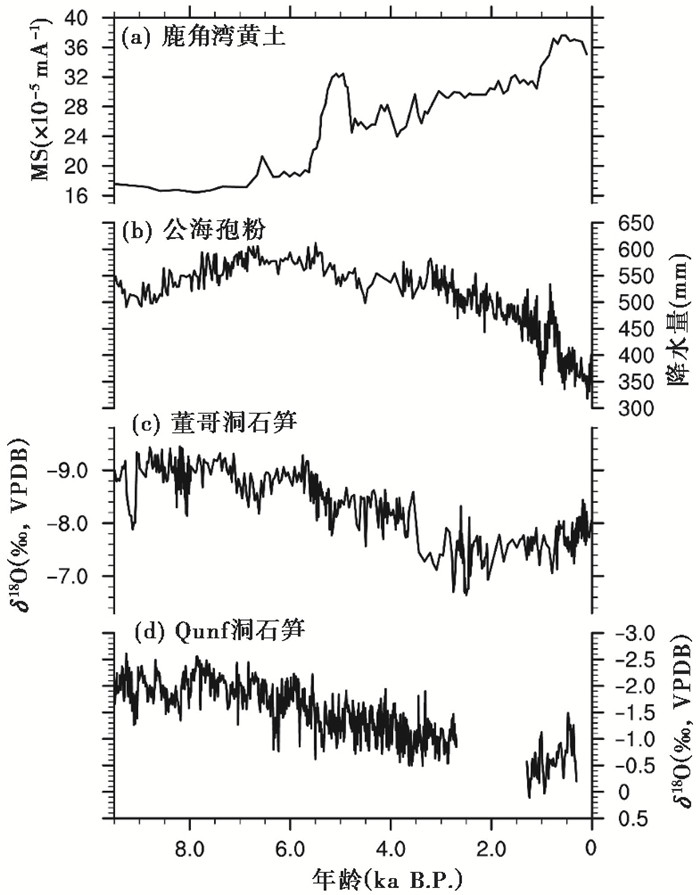
|
图 5 代用记录重建的全新世降水变化 (a)新疆鹿角湾黄土记录[45],(b)中国北方公海孢粉记录[47],(c)中国南方董哥洞石笋氧同位素记录[48],(d)阿曼Qunf洞石笋氧同位素记录[49] Fig. 5 Reconstructed precipitation changes during the Holocene. (a)Lujiaowan loess record in Xinjiang[45]; (b)Pollen record of Gonghai Lake in Northern China[47]; (c)δ 18 O record of Dongge cave in Southern China[48]; (d)δ 18 O record of Qunf cave in Oman[49] |
为了分析南亚高压南北偏向指数INS与夏季降水的关系,将模拟的每个格点的夏季降水与INS指数做相关分析,图 6a为INS与夏季降水的相关系数,轨道尺度上,印度季风区的阿拉伯半岛、伊朗高原、印度半岛绝大部分地区、青藏高原和东亚季风区的中国北方、蒙古东部均与INS指数有显著的正相关关系,而中南半岛南部、中国中部和南方大部分地区、日本等区域的降水则与INS指数有显著的负相关关系,此外,季风区外的中亚东部和中国南疆地区的降水与INS指数也有显著的负相关关系。为进一步探讨INS与亚洲地区降水的内在联系,我们将INS与亚洲地区降水的线性趋势均滤掉,发现它们的相关关系在绝大部分地区仍然非常显著,并且相关模态除中南半岛北部、中国东南沿海和日本外,均没有发生变化。总体来说,INS指数与印度夏季风降水呈显著的正相关关系,与西南季风降水呈显著的负相关关系,与东亚季风区北部呈显著的正相关关系而南部则为显著的负相关关系。一般认为东亚季风区北部降水较多反映了较强的东亚夏季风强度,而南部降水较多则反映了较弱的东亚夏季风强度[50],因此,INS指数与东亚夏季风强度呈正相关关系。为进一步验证INS指数与东亚夏季风和印度夏季风的正相关关系,我们同时比较INS指数与东亚夏季风指数和印度夏季风指数的相关关系,INS指数与东亚夏季风指数和印度夏季风指数均有显著的正相关关系(图 7),它们的相关系数分别为0.51和0.47,相关关系在去掉趋势后均为0.34,都通过0.01显著性检验。因此,INS指数与亚洲夏季风系统呈现正相关关系。
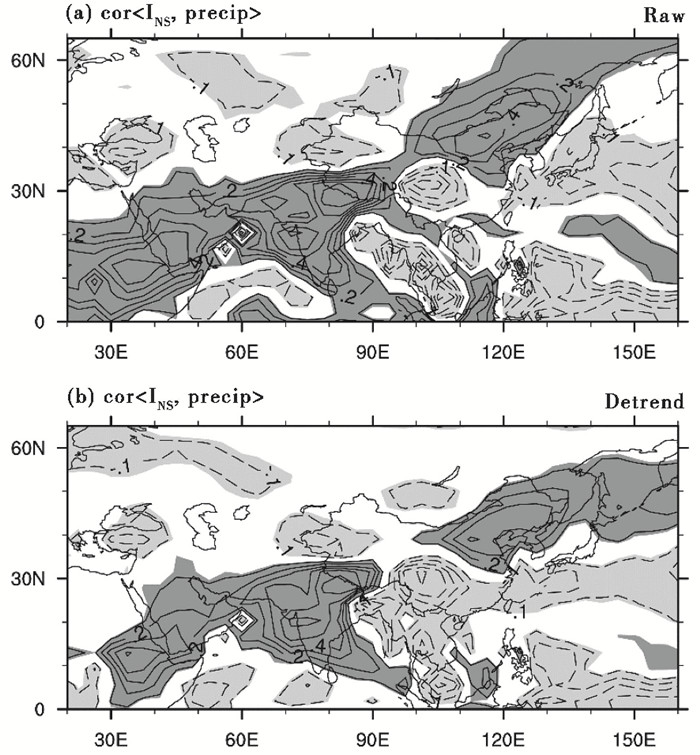
|
图 6 夏季降水与INS的相关关系 (a)去趋势前,(b)去趋势后;灰色阴影区为相关关系通过0.01显著性检验 Fig. 6 Correlations between summer precipitation and the INS during the Holocene (a) without and (b) with the removal of the long-term trends. Areas exceeding the 0.01 confidence level are shaded |
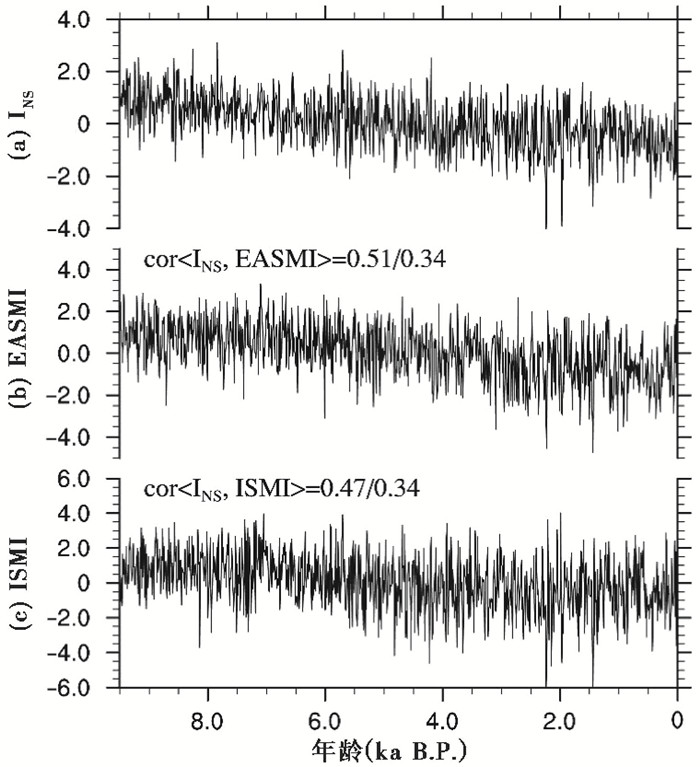
|
图 7 南亚高压南北偏向指数(a)与东亚夏季风指数(b)、印度夏季风指数(c)的对比 东亚夏季风指数定义为10°~50°N范围内160°E与110°E夏季海平面气压差[51],印度夏季风指数定义为印度季风区范围内(0°~20°N和40°~110°E) 850 hPa和200 hPa纬向风异常之差[52];cor表示相关关系,斜杠前的数字表示两个原始序列的相关系数,斜杠后的数字表示滤掉线性趋势后的相关系数 Fig. 7 Comparisons of the INS (a)with the East Asian summer monsoon index(EASMI) (b)and Indian summer monsoon index(ISMI) (c). The EASMI is defined as the summation of summer sea-level pressure difference from 10°N to 50°N between 160°E and 110°E[51], while the ISMI is defined as the difference of summer zonal wind anomalies at 850 hPa and 200 hPa averaged over the ISM region(0°~20°N, 40°~110°E)[52]. "cor" indicates the correlation. The numbers before(after)the slash indicate the correlation coefficients between two raw time series(detrended time series) |
如前面分析,虽然早全新世较多的夏季太阳辐射使得亚洲夏季风强度增强,但亚洲季风区内并非所有区域降水都增加,而在印度半岛东部、中南半岛南部、中国中部、朝鲜半岛以及日本等地区降水反而减少(图 4),其中印度半岛东部、中南半岛南部和中国中部的降水与INS指数存在显著的负相关关系(图 6b),因此,早全新世较偏北的南亚高压可能对这3个地区降水的减少有重要作用。
3 讨论 3.1 全新世南亚高压南北移动可能物理机制探讨全新世以来,南亚高压中心逐渐向南移动,响应于不断减少的夏季太阳辐射,那么,夏季太阳辐射的变化是如何影响着南亚高压中心位置?本文南亚高压南北移动指数(INS)定义为27.5°~32.5°N和50°~100°E范围内与22.5°~27.5°N和50°~100°E范围内200 hPa位势高度之差,这个指数反映了27.5°N南北两侧位势高度变化的跷跷板结构,当INS偏正时,南亚高压中心偏北,27.5°N以北200 hPa位势高度正异常,而以南200 hPa位势高度负异常。在早全新世,无论是27.5°~32.5°N和50°~100°E范围内,还是22.5°~27.5°N和50°~100°E范围内,200 hPa位势高度均较晚全新世增加,但27.5°N以北增幅较南部大(图 8a),从而使得早全新世INS偏正,南亚高压中心偏北。那么,夏季太阳辐射是如何导致早全新世27.5°~32.5°N和50°~100°E范围内200 hPa位势高度较晚全新世有显著的增加?
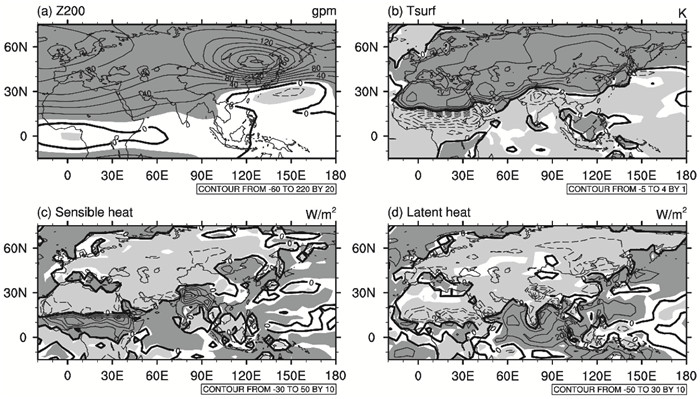
|
图 8 早全新世(9.5~8.5 ka B.P.)夏季200 hPa位势高度(单位:gpm) (a)、地表温度(单位:℃) (b)、感热通量(单位:W/m2,向下为正) (c)和潜热通量(单位:W/m2,向下为正) (d)相对于晚全新世(1~0 ka B.P.)的差值 灰色阴影区为差值变化通过0.01显著性检验 Fig. 8 Changes in summer mean geopotential height at 200 hPa(units: gpm) (a), surface air temperature(units:℃) (b), sensible heat flux(units:W/m2, downward fluxes are positive) (c), and latent heat flux(units:W/m2, downward fluxes are positive)(d) during the Early Holocene(9.5~8.5 ka B.P.)relative to the Late Holocene(1~0 ka B.P.). Shaded areas indicate changes that are significant at the 0.01 confidence level |
太阳辐射最直接的效应就是对地表的加热作用。早全新世,由于夏季太阳辐射增加,北半球中高纬陆地出现显著的增温,而中低纬出现降温,与代用记录一致[53],降温在印度半岛和北非(5°~20°N之间)尤其明显(图 8b),这个降温很可能是由于早全新世赤道辐合带向北偏移,并且强度增强[54],使得这两个地区气流上升,云量增加,阻挡了太阳辐射的进入,从而温度降低,进而使得这些区域感热输送减弱(图 8c)。在早全新世,只有伊朗高原向上层输送的感热通量增加,而伊朗高原的感热加热也是形成和维持南亚高压的一个重要因素[3],从而也可能是南亚高压偏北的一个重要原因。伊朗高原也是太阳辐射增加引起显著增温的区域,因此,太阳辐射可以通过加强伊朗高原的感热加热,从而影响南亚高压。除感热加热外,青藏高原降水所导致的凝结潜热释放是南亚高压形成的最重要的原因之一[2~3]。早全新世,由于赤道辐合带的北移和加强[54],青藏高原的降水相对于晚全新世增加了80 %以上(图 4),相应地,这一区域的潜热释放也显著增加(图 8d),可以进一步加强南亚高压。总的来说,在早全新世青藏高原感热加热减弱,而潜热加热增强,两者可能存在一定的抵消,而伊朗高原上,无论潜热加热还是感热加热均增强,而这一区域主要位于27.5°N以北,从而使得27.5°N以北气压增加较以南更显著(图 8a),因此偏北。
3.2 全新世南亚高压南北移动与亚洲夏季风降水的联系机制南亚高压作为亚洲夏季风系统的重要组成部分,其中心位置的南北移动与全新世亚洲季风区甚至内陆区的夏季降水有显著的相关关系[12~13, 16],那么与南亚高压南北移动相关的大气环流是如何配置的?这种大气环流配置是如何影响到亚洲夏季风降水的?
由于引起全新世南亚高压南北移动的主要原因为200 hPa高度上27.5°N以北的位势高度显著增加,当南亚高压中心位置偏北时,对流层上层200 hPa高度上,中纬度地区存在两个异常反气旋,这两个反气旋中心分别位于中亚和东亚(图 9a)。在这两个高压中心的南部(20°~35°N之间)为宽广的东风异常带,而在北部(40°~50°N之间)为显著的西风异常带,这一模态与现代完全一致[13]。在东亚上空的反气旋环流异常使得中国北方和蒙古东部地区上空辐散,有利于上升运动的发生,进而造成这些区域降水增加。在对流层中层500 hPa高度上(图 9b),环流形式与上层相似,但异常反气旋中心较上层偏东及偏南,这一异常反气旋可以加强西太副高强度,有利于将来自于西北太平洋的水汽输送到东亚北部地区,从而进一步增加这一区域的降水。因此,南亚高压南北偏移指数与东亚夏季风有显著的正相关关系。
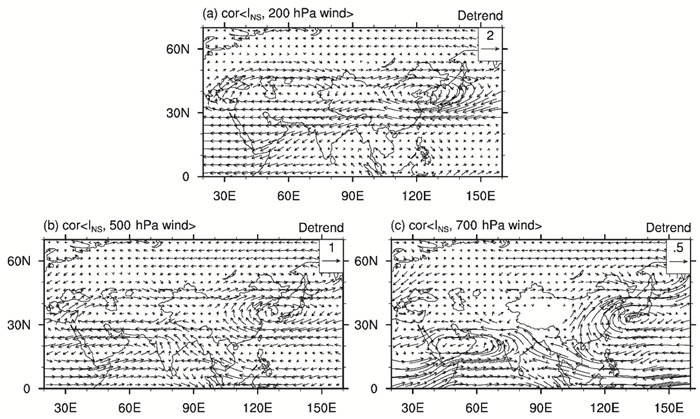
|
图 9 INS(去趋势)回归的风场异常(去趋势) (a)200 hPa,(b)500 hPa,(c)700 hPa Fig. 9 Regressed summer winds at (a)200 hPa, (b)500 hPa, and (c)700 hPa against the INS after the removal of the long-term trends |
在中国中部地区的对流层上层,南亚高压偏北时,为异常的东风槽,气流在高空辐合,相应在对流层下层气流辐散,不利于上升运动的发生,从而使得中国中部地区降水减少。在西南季风影响下的中国西南地区和中南半岛,由于从对流层上层到下层存在宽广的异常东风带(图 9),这一区域对流层中下层西南风减弱,从而减弱了来自孟加拉湾的水汽输入,最终导致中国西南地区和中南半岛降水减少。因此,南亚高压南北偏移指数与中国中部地区、西南季风区的降水存在显著的负相关关系(图 9b)。
在印度季风区,南亚高压偏北时,其北部的上层有一个异常反气旋(图 9a),这一异常反气旋在对流层中层的500 hPa高度上也存在,但位置相对靠南(图 9b)。而在这个反气旋的南部,存在着一个异常气旋环流(图 9b),这个异常气旋环流同时也存在于对流层中下层(图 9c),它可以直接导致印度夏季风降水增加。因此,南亚高压南北偏移指数与印度夏季风降水存在显著的正相关关系(图 6b)。
王宁等[18]曾利用KCM对全新世的气候模拟研究了南亚高压东脊点的东西移动特征,并探讨了其与东亚夏季风的关系,研究发现南亚高压东脊点在全新世以来先向西移动,到中全新世后再向东移动,响应于春季太阳辐射的变化。南亚高压的东西移动与东亚夏季风存在不稳定的关系,在早中全新世存在正相关关系,而中晚全新世存在负相关关系。相比较而言,本文的南亚高压南北移动与东亚夏季风在整个全新世期间有比较一致的关系,此外与西南季风和印度季风也有显著的相关关系,因此,南亚高压的南北振荡可以较好地解释亚洲夏季风降水的变化。
本文的全新世模拟试验只考虑了轨道强迫,而忽略了大陆冰盖、温室气体和淡水注入等因素,这些因素可能影响南亚高压中心位置,特别是早全新世残余的北美冰盖可能引起西风带往南扩展[47],同时使得南亚高压向南移动,此外,在温室气体引起的全球变暖背景下,南亚高压中心位置持续向南偏移[13]。因此,未来还需要开展进一步的全新世模拟试验,研究大陆冰盖和温室气体等强迫因子对南亚高压中心南北移动的影响。
4 结论本文基于KCM模式在轨道参数强迫下对过去9.5 ka气候的模拟,探讨了全新世以来南亚高压的南北振荡特征,并分析了南北振荡的物理机制,同时比较了南亚高压与亚洲夏季风降水的关系,并探讨了它们的联系机制,结论如下:
(1) 全新世以来,南亚高压逐渐向南移动,与之相伴对流层上层西风环流也逐渐向南扩张,主要响应于夏季太阳辐射的变化。
(2) 早全新世南亚高压偏北主要是由于27.5°N以北200 hPa位势高度相对于晚全新世的增幅较27.5°N以南大。早全新世夏季太阳辐射增加引起伊朗高原增温,进而使得感热加热增强,引起伊朗高原上空出现辐散,200 hPa位势高度显著增加,最终导致南亚高压中心偏北。
(3) 南亚高压的南北移动与亚洲夏季风降水密切相关,南亚高压偏北时,东亚季风区北部和印度季风区降水偏多,而西南季风区和东亚季风区南部降水偏少。总的来说,南亚高压偏北时东亚夏季风和印度夏季风强度增强,西南季风强度减弱。南亚高压的南北移动可以部分解释全新世亚洲夏季风降水的空间差异。
(4) 南亚高压的南北移动主要通过影响大气的垂直运动和水汽的输送来影响亚洲夏季风降水。南亚高压偏北时,东亚北部上升气流增强,并且输送到东亚北部的水汽也增加,从而使得这一区域降水增加。南亚高压偏北往往伴随着西南季风区上空异常东风,使得从孟加拉湾输送的水汽减弱,西南季风降水减少。偏北的南亚高压也使得阿拉伯海上空出现异常气旋,从而使得印度夏季风降水增加。
致谢: 感谢审稿专家和杨美芳编辑建设性的修改意见。
| [1] |
Flohn H. Recent investigation on the mechanism of the summer monsoon of Southern and Eastern Asia[C]//Proceeding of Symposium Monsoon of the World. New Delhi: Hind Union Press, 1960: 75-88. http://ci.nii.ac.jp/naid/10014597738
|
| [2] |
Wu G, Zhuo H, Wang Z, et al. Two types of summertime heating over the Asian large-scale orography and excitation of potential-vorticity forcing Ⅰ. Over Tibetan Plateau[J]. Science China:Earth Sciences, 2016, 59(10): 1996-2008. DOI:10.1007/s11430-016-5328-2 |
| [3] |
Liu Y, Wang Z, Zhuo H, et al. Two types of summertime heating over Asian large-scale orography and excitation of potential-vorticity forcing Ⅱ. Sensible heating over Tibetan-Iranian Plateau[J]. Science China:Earth Sciences, 2017, 47(3): 354-366. |
| [4] |
吴国雄, 李伟平, 郭华, 等.青藏高原感热气泵和亚洲夏季风[M]//叶笃正.赵九章纪念文集.北京: 科学出版社, 1997: 116-126. Wu Guoxiong, Li Weiping, Guo Hua, et al. Tibetan Plateau sensible heat pump and Asian summer monsoon[M]//Ye Duzheng. Memorial Corpus for Zhao Jiuzhang. Beijing: Science Press, 1997: 116-126. |
| [5] |
吴国雄, 刘屹岷. 热力适应、过流、频散和副高Ⅰ.热力适应和过流[J]. 大气科学, 2000, 24(4): 433-446. Wu Guoxiong, Liu Yimin. Thermal adaptation, overshooting, dispersion, and subtropical anticyclone Part Ⅰ:Thermal adaptation and overshooting[J]. Chinese Journal of Atmospheric Sciences, 2000, 24(4): 433-446. DOI:10.3878/j.issn.1006-9895.2000.04.01 |
| [6] |
罗四维, 钱正安, 王谦谦. 夏季100毫巴青藏高压与我国东部旱涝关系的天气气候研究[J]. 高原气象, 1982, 1(2): 1-10. Luo Siwei, Qian Zheng'an, Wang Qianqian. The climatic and synoptical study about the relation between the Qinghai-Xizang high pressure on the 100 mb surface and the flood and drought in East China in summer[J]. Plateau Meteorology, 1982, 1(2): 1-10. |
| [7] |
陶诗言, 朱福康. 夏季亚洲南部100毫巴流型的变化及其与西太平洋副热带高压进退的关系[J]. 气象学报, 1964, 34(4): 385-396. Dao Shihyen, Chu Fukang. The 100-mb flow patterns in Southern Asia in summer and its relation to the advance and retreat of the West-Pacific subtropical anticyclone over the Far East[J]. Acta Meteorologica Sinica, 1964, 34(4): 385-396. |
| [8] |
朱乾根, 林锦瑞, 寿绍文, 等. 天气学原理和方法[M]. 北京: 气象出版社, 2007: 152-153. Zhu Qiangen, Lin Jinrui, Shou Shaowen, et al. Principles and Methods of Synoptic Meteorology[M]. Beijing: China Meteorological Press, 2007: 152-153. |
| [9] |
陈永仁, 李跃清. 夏季北半球极涡与南亚高压东西振荡的关系[J]. 高原气象, 2007, 26(5): 1067-1076. Chen Yongren, Li Yueqing. Relationships between polar vortex and oscillation of South Asia High in east and west directions[J]. Plateau Meteorology, 2007, 26(5): 1067-1076. |
| [10] |
Zhang Q, Wu G, Qian Y. The Bimodality of the 100 hPa South Asia High and its relationship to the climate anomaly over East Asia in summer[J]. Journal of the Meteorological Society of Japan, 2002, 80(4): 733-744. DOI:10.2151/jmsj.80.733 |
| [11] |
吴国雄, 毛江玉, 段安民, 等. 青藏高原影响亚洲夏季气候研究的最新进展[J]. 气象学报, 2004, 62(5): 528-540. Wu Guoxiong, Miao Jiangyu, Duan Anmin, et al. Recent progress in the study on the impacts of Tibetan Plateau on Asian summer climate[J]. Acta Meteorologica Sinica, 2004, 62(5): 528-540. DOI:10.3321/j.issn:0577-6619.2004.05.002 |
| [12] |
Wei W, Zhang R, Wen M, et al. Interannual variation of the South Asian High and its relation with Indian and East Asian summer monsoon rainfall[J]. Journal of Climate, 2015, 28(7): 2623-2634. DOI:10.1175/JCLI-D-14-00454.1 |
| [13] |
魏维, 张人禾, 温敏. 南亚高压的南北偏移与我国夏季降水的关系[J]. 应用气象学报, 2012, 23(6): 650-659. Wei Wei, Zhang Renhe, Wen Min. Meridional variation of South Asian High and its relationship with the summer precipitation over China[J]. Journal of Applied Meteorological Science, 2012, 23(6): 650-659. DOI:10.3969/j.issn.1001-7313.2012.06.002 |
| [14] |
刘伯奇, 何金海, 王黎娟. 4~5月南亚高压在中南半岛上空建立过程特征及其可能机制[J]. 大气科学, 2009, 33(6): 1319-1332. Liu Boqi, He Jinhai, Wang Lijuan. Characteristics of the South Asia High establishment processes above the Indo-China Peninsula from April to May and their possible mechanism[J]. Chinese Journal of Atmospheric Sciences, 2009, 33(6): 1319-1332. DOI:10.3878/j.issn.1006-9895.2009.06.17 |
| [15] |
He J, Wen M, Wang L, et al. Characteristics of the onset of the Asian Summer Monsoon and the importance of Asian-Australian "land bridge"[J]. Advances in Atmospheric Sciences, 2006, 23(6): 951-963. DOI:10.1007/s00376-006-0951-z |
| [16] |
Wei W, Zhang R, Wen M, et al. Relationship between the Asian westerly jet stream and summer rainfall over Central Asia and North China:Roles of the Indian monsoon and the South Asian High[J]. Journal of Climate, 2017, 30(2): 537-552. DOI:10.1175/JCLI-D-15-0814.1 |
| [17] |
张菁, 范广洲, 赖欣, 等. 南亚高压上下高原时间及其与高原季风建立早晚的关系[J]. 气象科学, 2017, 37(1): 30-40. Zhang Jing, Fan Guangzhou, Lai Xin, et al. Establishment or retreatment average date of South Asian High over the Tibetan Plateau and its relation with the Tibetan Plateau monsoon onset[J]. Journal of the Meteorological Sciences, 2017, 37(1): 30-40. |
| [18] |
王宁, 张肖剑, 靳立亚. 千年时间尺度南亚高压和西太平洋副热带高压关系的时空变化特征[J]. 第四纪研究, 2015, 35(6): 1425-1436. Wang Ning, Zhang Xiaojian, Jin Liya. The spatial and temporal variation characteristics of the South Asia High and Western Pacific Subtropical High on millennial time scale[J]. Quaternary Sciences, 2015, 35(6): 1425-1436. |
| [19] |
Cheng H, Edwards R L, Sinha A, et al. The Asian monsoon over the past 640, 000 years and ice age terminations[J]. Nature, 2016, 534: 640-646. DOI:10.1038/nature18591 |
| [20] |
王岳, 李育, 张成琦. 河西走廊东西段全新世古湖泊演化对比研究[J]. 第四纪研究, 2017, 37(3): 581-596. Wang Yue, Li Yu, Zhang Chengqi. The comparative study of paleolakes evolution between the eastern and western parts of the Hexi corridor in Holocene[J]. Quaternary Sciences, 2017, 37(3): 581-596. |
| [21] |
张志平, 黄伟, 陈建徽, 等. 全新世东亚夏季风演化的多尺度周期变化及其可能机制探讨[J]. 第四纪研究, 2017, 37(3): 498-509. Zhang Zhiping, Huang Wei, Chen Jianhui, et al. Multi-time scale analysis of East Asian summer monsoon and its possible mechanism during Holocene[J]. Quaternary Sciences, 2017, 37(3): 498-509. |
| [22] |
Jiang D, Tian Z, Lang X. Mid-Holocene net precipitation changes over China:Model-data comparison[J]. Quaternary Science Reviews, 2013, 82: 104-120. DOI:10.1016/j.quascirev.2013.10.017 |
| [23] |
吴鹏飞, 刘征宇, 程军, 等. 中全新世以来东亚夏季降水时空演变不一致性的模拟研究[J]. 第四纪研究, 2013, 33(6): 1138-1147. Wu Pengfei, Liu Zhengyu, Cheng Jun, et al. A simulation study on spatio-temporal asynchronism of East Asian summer's precipitation variation since the mid-Holocene[J]. Quaternary Sciences, 2013, 33(6): 1137-1147. |
| [24] |
Liu Z, Wen X, Brady E C, et al. Chinese cave records and the east Asia summer monsoon[J]. Quaternary Science Reviews, 2014, 83: 115-128. DOI:10.1016/j.quascirev.2013.10.021 |
| [25] |
Shi Z, Liu X, Cheng X. Anti-phased response of northern and southern East Asian summer precipitation to ENSO modulation of orbital forcing[J]. Quaternary Science Reviews, 2012, 40: 30-38. DOI:10.1016/j.quascirev.2012.02.019 |
| [26] |
Li X, Liu X, Zhao H. Transient simulation of the Tibetan Plateau modulated distinct orbital-scale precipitation variation in East and South Asia[J]. Palaeogeography, Palaeoclimatology, Palaeoecology, 2017, 485: 899-905. DOI:10.1016/j.palaeo.2017.08.005 |
| [27] |
吴海斌, 李琴, 于严严, 等. 全新世中期中国气候格局定量重建[J]. 第四纪研究, 2017, 37(5): 982-998. Wu Haibin, Li Qin, Yu Yanyan, et al. Quantitative climate reconstruction in China during the mid-Holocene[J]. Quaternary Sciences, 2017, 37(5): 982-998. |
| [28] |
Chiang J C H, Fung I Y, Wu C H, et al. Role of seasonal transitions and westerly jets in East Asian paleoclimate[J]. Quaternary Science Reviews, 2015, 108: 111-129. DOI:10.1016/j.quascirev.2014.11.009 |
| [29] |
Tian Z, Jiang D. Mid-Holocene ocean and vegetation feedbacks over East Asia[J]. Climate of the Past, 2013, 9(5): 2153-2171. DOI:10.5194/cp-9-2153-2013 |
| [30] |
姜大膀, 田芝平. 末次冰盛期和全新世中期东亚地区水汽输送的模拟研究[J]. 第四纪研究, 2017, 37(5): 999-1008. Jiang Dabang, Tian Zhiping. Last Glacial Maximum and mid-Holocene water vapor transport over East Asia:A modeling study[J]. Quaternary Sciences, 2017, 37(5): 999-1008. |
| [31] |
Park W, Keenlyside N, Latif M, et al. Tropical Pacific climate and its response to global warming in the Kiel climate model[J]. Journal of Climate, 2009, 22(1): 71-92. DOI:10.1175/2008JCLI2261.1 |
| [32] |
Roeckner E, Bäuml G, Bonaventura L, et al. The atmospheric general circulation model ECHAM 5. PartⅠ:Model description[M]. Hamburg: Max Planck Institut für Meteorologie, 2003: 5-127.
|
| [33] |
Park W, Latif M. Multidecadal and multicentennial variability of the meridional overturning circulation[J]. Geophysical Research Letters, 2008, 35(22): L22703. DOI:10.1029/2008GL035779 |
| [34] |
Park W, Latif M. Pacific and Atlantic multidecadal variability in the Kiel Climate Model[J]. Geophysical Research Letters, 2010, 37(24): L24702. DOI:10.1029/2010GL045560 |
| [35] |
Latif M, Park W, Ding H, et al. Internal and external North Atlantic sector variability in the Kiel climate model[J]. Meteorologische Zeitschrift, 2009, 18(4): 433-443. DOI:10.1127/0941-2948/2009/0395 |
| [36] |
焦腾腾, 李佳瑞, 陈婕, 等. 全新世北大西洋海面温度变化趋势:观测-模拟对比研究[J]. 第四纪研究, 2016, 36(3): 747-757. Jiao Tengteng, Li Jiarui, Chen Jie, et al. Changing trends of sea surface temperatures in the North Atlantic during the Holocene:A study of model-data comparison[J]. Quaternary Sciences, 2016, 36(3): 747-757. |
| [37] |
Berger A, Loutre M F. Insolation values for the climate of the last 10 million years[J]. Quaternary Science Reviews, 1991, 10(4): 297-317. DOI:10.1016/0277-3791(91)90033-Q |
| [38] |
Jin L, Schneider B, Park W, et al. The spatial-temporal patterns of Asian summer monsoon precipitation in response to Holocene insolation change:a model-data synthesis[J]. Quaternary Science Reviews, 2014, 85(2): 47-62. |
| [39] |
Lorenz S, Lohmann G. Acceleration technique for Milankovitch type forcing in a coupled atmosphere-ocean circulation model:Method and application for the Holocene[J]. Climate Dynamics, 2004, 23(7-8): 727-743. DOI:10.1007/s00382-004-0469-y |
| [40] |
Schneider B, Leduc G, Park W. Disentangling seasonal signals in Holocene climate trends by satellite-model-proxy integration[J]. Paleoceanography, 2010, 25(4): PA4217. DOI:10.1029/2009PA001893 |
| [41] |
Otto-Bleisner B L, Braconnot P, Harrison S P, et al. The PMIP 4 contribution to CMIP 6-Part 2:Two interglacials, scientific objective and experimental design for Holocene and Last Interglacial simulations[J]. Geoscientific Model Development, 2017, 10(11): 3979-4003. DOI:10.5194/gmd-10-3979-2017 |
| [42] |
韩鹏, 刘兴起. 内蒙古中东部查干淖尔湖流域7000年以来的气候演变[J]. 第四纪研究, 2017, 37(6): 1381-1390. Han Peng, Liu Xingqi. The climate evolution inferred from Chagan-Nuur in middle-east part of Inner Mongolia since the last 7000 years[J]. Quaternary Sciences, 2017, 37(6): 1381-1390. |
| [43] |
张恩楼, 孙伟伟, 刘恩峰, 等. 末次冰盛期以来洱海沉积物元素碳同位素特征与区域植被组成变化[J]. 第四纪研究, 2017, 37(5): 1027-1036. Zhang Enlou, Sun Weiwei, Liu Enfeng, et al. Vegetation change reconstructed by a stable isotope record of elemental carbon from Lake Erhai, Southwest China since the Last Glacial Maximum[J]. Quaternary Sciences, 2017, 37(5): 1027-1036. |
| [44] |
范佳伟, 肖举乐, 温锐林, 等. 内蒙古达里湖全新世有机碳氮同位素记录与环境演变[J]. 第四纪研究, 2015, 35(4): 856-870. Fan Jiawei, Xiao Jule, Wen Ruilin, et al. Holocene environment variations recorded by stable carbon and nitrogen isotopes of sedimentary organic matter from Dali Lake in Inner Mongolia[J]. Quaternary Sciences, 2015, 35(4): 856-870. |
| [45] |
Chen F, Jia J, Chen J, et al. A persistent Holocene wetting trend in arid Central Asia, with wettest conditions in the Late Holocene, revealed by multi-proxy analyses of loess-paleosol sequences in Xinjiang, China[J]. Quaternary Science Reviews, 2016, 146: 134-146. DOI:10.1016/j.quascirev.2016.06.002 |
| [46] |
Zhang D, Feng Z, Yang Y, et al. Peat δ13C celluose-recorded wetting trend during the past 8000 years in the southern Altai Mountains, northern Xinjiang, NW China[J]. Journal of Asian Earth Sciences, 2018, 156: 174-179. DOI:10.1016/j.jseaes.2018.01.029 |
| [47] |
Chen F, Xu Q, Chen J, et al. East Asian summer monsoon precipitation variability since the last deglaciation[J]. Scientific Reports, 2015, 5: 11186. DOI:10.1038/srep11186 |
| [48] |
Dykoski C A, Edwards R L, Cheng H, et al. A high-resolution, absolute-dated Holocene and deglacial Asian monsoon record from Dongge cave, China[J]. Earth and Planetary Science Letters, 2005, 233(1-2): 71-86. DOI:10.1016/j.epsl.2005.01.036 |
| [49] |
Fleitmann D, Burns S J, Mudelsee M, et al. Holocene forcing of the Indian monsoon recorded in a stalagmite from southern Oman[J]. Science, 2003, 300(5626): 1737-1739. DOI:10.1126/science.1083130 |
| [50] |
Liu J, Chen J, Zhang X, et al. Holocene East Asian summer monsoon records in Northern China and their inconsistency with Chinese stalagmite δ18O records[J]. Earth-Science Reviews, 2015, 148: 194-208. DOI:10.1016/j.earscirev.2015.06.004 |
| [51] |
郭其蕴. 东亚夏季风强度指数及其变化的分析[J]. 地理学报, 1983, 38(3): 207-217. Guo Qiyun. The summer monsoon intensity index in East Asia and its variation[J]. Acta Geographica Sinica, 1983, 38(3): 207-217. DOI:10.3321/j.issn:0375-5444.1983.03.001 |
| [52] |
Webster P J, Yang S. Monsoon and ENSO:Selectively interactive systems[J]. Quarterly Journal of the Royal Meteorological Society, 1992, 118(507): 877-926. DOI:10.1002/(ISSN)1477-870X |
| [53] |
Marcott S A, Shakun J D, Clark P U, et al. A reconstruction of regional and global temperature for the past 11, 300 years[J]. Science, 2013, 339(6124): 1198-1201. DOI:10.1126/science.1228026 |
| [54] |
Haug G H, Hughen K A, Sigman D M, et al. Southward migration of the intertropical convergence zone through the Holocene[J]. Science, 2001, 293(5533): 1304-1308. DOI:10.1126/science.1059725 |
2 School of Atmospheric Sciences, Chengdu University of Information Technology, Chengdu 610225, Sichuan)
Abstract
The South Asian High is the most intense and persistent anticyclone in the upper troposphere in boreal summer, which is an important member of the Asian summer monsoon system. The South Asian High, in particular its position, plays an important role in the regional climate anomaly over Asia. The behaviors of the South Asian High have been extensively studied on the interannual-decadal time scales in present-day climate. However, its variability is rarely discussed on longer time scales during the Holocene. With the Kiel Climate model(KCM), this study simulated the Holocene climate to analysis the meridional movement of the South Asian High and its effect on Asian summer monsoon precipitation during the Holocene. The KCM is a coupled atmosphere-ocean-sea ice general circulation model. The model comprises the spectral atmospheric model ECHAM5 and the Nucleus for European Modeling of the Ocean(NEMO) ocean-sea ice general circulation model, coupled through OASIS3. The horizontal resolution of the atmospheric model ECHAM5 is T31(3.75°×3.75°), and in the vertical direction there are 19 levels up to 10 hPa. The horizontal resolution of the ocean model NEMO is on average 1.3° based on 2° Mercator meshes with grid refinement in the tropical regions, where the meridional grid-point separation reaches 0.5°. The Holocene climate simulation is forced by the Earth's orbital parameters for the period from 9.5 ka B.P. to 0 ka B.P. with a tenfold acceleration. Other factors, including ice-sheets and greenhouse gases concentrations, are kept the same as the pre-industrial levels. The South Asian High has experienced a persistent southward migration during the Holocene, following summer insolation. Accompanied by the southward migration of the South Asian High, the upper-level westerlies expanded southward during the Holocene. The southward migration of the South Asian High was mainly caused by the cooling of the Iranian Plateau resulting from the reducing summer insolation. The cooling of the Iranian plateau weakened the sensible heating, which further weakened the low-level convergence and the resultant upper-level divergence over the northern part of the South Asian High, ultimately leading to a southward migration of the South Asian High. The meridional migration of the South Asian High was closely related to Asian summer monsoon precipitation anomalies. A northward displacement of the South Asian High was associated with enhanced precipitation in northern East Asia and South Asia, and reduced precipitation in Central China, southern East Asia and Indochina Peninsula. Anomalous upward motions in northern East Asia and enhanced moisture transport towards northern East Asia were associated with a northward displacement of the South Asian High, leading to increased precipitation in northern East Asia. However, anomalous downward motions in Central Asia and weakened moisture transport towards southern East Asia and Indochina Peninsula were related to a northward displacement of the South Asian High, resulting in decreased precipitation in Central China, southern East Asia and Indochina Peninsula. A northward migration of the South Asian High induced anomalous cyclone over the Arabian Sea, causing enhanced precipitation in South Asia. Generally, the southward migration of the South Asian High was associated with a weakened East Asian summer monsoon and Indian summer monsoon, and an enhanced southwest monsoon. The spatial-temporal patterns of Asian summer monsoon precipitation during the Holocene can be partially explained by the meridional movement of the South Asian High. 2018, Vol.38
2018, Vol.38
